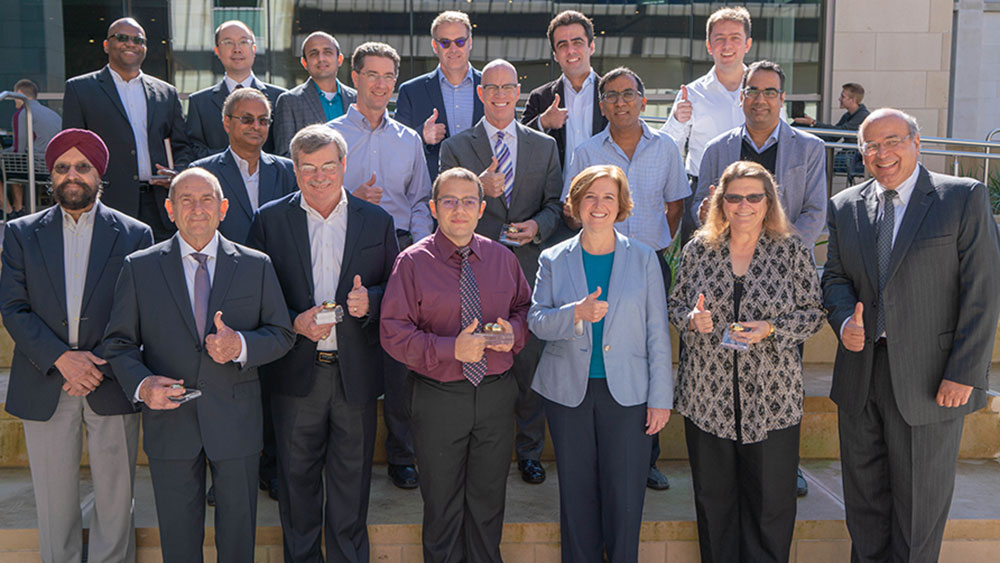
The Engineering Genesis Award for Multidisciplinary Research was presented to 20 Texas A&M Engineering Experiment Station (TEES) researchers and their teams during the TEES External Advisory Board meeting Oct. 26.
The award, which is presented to TEES researchers who have secured significant research grants of $1 million or more, were given to the following:
PI: Michael Demkowicz, materials science and engineering. Co-PIs: Karl Hartwig, Alan Needleman and George M. Pharr, materials science and engineering.
- $12.5 million grant from the Department of Energy-National Nuclear Security Administration for the “Center for Research Excellence on Dynamically Deformed Solids (CREDDS): Discovering the Role of Heterogeneities in High Strain Rate Mechanical Response.”
PI: Dan Hill, petroleum engineering. Co-PIs: George Moridis, David Schechter and Ding Zhu, petroleum engineering.
- $6 million grant from the Department of Energy for “The Eagle Ford Shale Laboratory: A Field Study of the Stimulated Reservoir Volume, Detailed Fracture Characteristics, and EOR Potential.”
PI: Daniel Ragsdale, computer science and engineering and director, Texas A&M Cybersecurity Center. Co-PIs: Paula Dewitte, Robert Jones, Dilma Da Silva and Guofei Gu, computer science and engineering.
- $4.4 million grant from the National Science Foundation for “The Texas A&M Cyber Leader Scholarship Program: Developing Cyber Leader-Scholars for the Nation.”
PI: Jean Ragusa, nuclear engineering. Co-PIs: Mark Kimber, Richard Kurwitz, Sean McDeavitt, Luis Ortega, Lin Shao and Pavel Tsvetkov, nuclear engineering.
- $3 million grant from the Department of Energy for “NuSTEM: Nuclear Science, Technology and Education for Molten Salt Reactors.”
PI: Javier Jo, biomedical engineering. Co-PIs: Brian Applegate, biomedical engineering; Yi-Shing Cheng and John Wright, Texas A&M Health Science Center.
- $2.5 million from the Department of Health and Human Services-National Institutes of Health-National Cancer Institute for “Endogenous Fluorescence Lifetime Endoscopy for Early Detection of Oral Cancer and Dysplasia.”
PI: Akhilesh Gaharwar, biomedical engineering.
- $2.2 million from the National Institutes of Health for “Mineralomics: Designing Mineral Based Therapeutics to Control and Direct Cell Function.”
PI: Jeyavijayan Rajendran, electrical and computer engineering.
- $2 million from the Department of Defense-Office of Naval Research for “Towards Verification-Guided Hardware Synthesis for Security.”
PI: Ali Mostafavidarani, civil engineering. Co-PIs: Philip Berke and Sierra Woodruff, land use and environmental planning; Arnold Vedlitz, public service and administration, Bush School of Government and Public Service; and Bjorn Birgisson, civil engineering.
- $2 million from the National Science Foundation for “CRISP 2.0 Type 2: Anatomy of Coupled Human-Infrastructure Systems Resilience to Urban Flooding: Integrated Assessment of Social, Institutional, and Physical Networks.”
PI: Helen Reed, aerospace engineering. Co-PIs: Rodney Bowersox and William Saric, aerospace engineering.
- $1.8 million from the Department of Defense-Air Force Office of Scientific Research for “Boundary Layer Transition (BOLT)-Experiment and Simulation (Concave Curvature and Leading-Edge Sweep Effects).”
PI: Yang Shen, electrical and computer engineering.
- $1.7 from the Department of Health and Human Services-National Institutes of Health-National Institute of General Medical Science for “Unraveling Molecular and System-Level Mechanisms of Human Disease-Associated Protein Mutations.”
PI: Mark Burris, civil engineering.
- $1.4 million from the Department of Transportation-Federal Highway Administration for “Topic 2, Behavioral Science and Experimental Economics Approaches for Transportation.”
PI: Michael McShane, biomedical engineering. Co-PI: Lee Hudson, biomedical engineering.
- $1.3 million from National Institutes of Health for “Minimally-Invasive Metabolite Monitoring Systems for In Vitro and In Vivo Disease Models.”
PI: Rodney Bowersox, aerospace engineering.
- $1.2 million from the Department of Defense-Office of Naval Research for “Turbulence Transport in Extreme Non-Equilibrium Environments.”
PI: Mladen Kezunovic, electrical and computer engineering. Co-PIs: Miroslav Begovic and Chanan Singh, electrical and computer engineering.
- $1.2 million from the Department of Energy for “UI-ASSIST: US-India Collaborative for Smart Distribution System with Storage.”
PI: Akhil Dattagupta, petroleum engineering.
- $1.2 million from the Department of Energy for “Robust Carbon Dioxide Imaging Using Joint Tomographic Inversion of Seismic Onset Time and Distributed Pressure and Temperature Measurements.”
PI: Bahman Yazdani, Energy Systems Laboratory. Co-PIs: Joseph Martinez, Ahmet Ugursal and Carlos Yagua, Energy Systems Laboratory; and Juan Carlos Baltazar, architecture.
- $1.1 million from the City of Houston for “Energy Management, Sustainability and M&V Services for Houston Airport System Q&M RFP.”
PI: Pushkar Lele, chemical engineering.
- $1 million from the National Institutes of Health for “Mechanical Regulation of Ultra-sensitivity in E. coli Flagellar Motors.”
PI: Karen Butler-Purry, provost’s office. Co-PIs: Samuel Merriweather, EDAC and Shannon Walton, GRST.
- $1.1 million from the National Science Foundation for “LSAMP BTD: Texas A&M University System Louis Stokes Alliance for Minority Participation (TAMUS LSAMP) Bridge to the Doctorate Cohort XIII (2018-2020) Program.”
PI: Jean Ragusa, nuclear engineering. Co-PIs: Marvin Adams and Jim Morel, nuclear engineering.
- $1 million from the Department of Defense—Defense Threat Reduction Agency for “Models with Multiple Levels of Fidelity, Tractability, and Computational Cost for Nuclear Weapon Radiation Effects.”
PI: Dan Hill, petroleum engineering.
- $1 million from Marathon Oil Company for “Marathon Oil Unconventional Fluid Flow/EOR.”